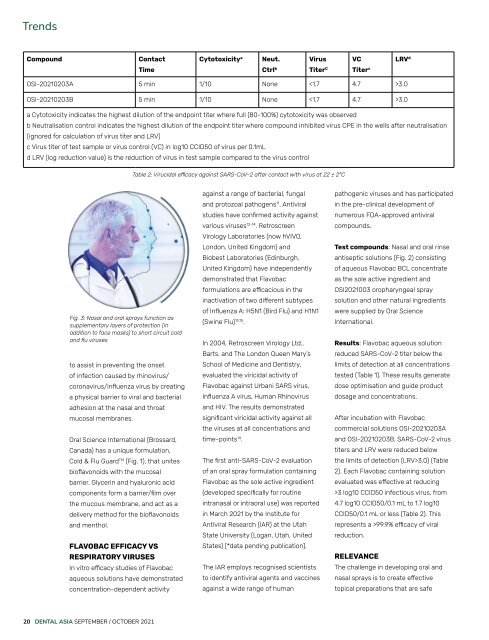Dental Asia September/October 2021
For more than two decades, Dental Asia is the premium journal in linking dental innovators and manufacturers to its rightful audience. We devote ourselves in showcasing the latest dental technology and share evidence-based clinical philosophies to serve as an educational platform to dental professionals. Our combined portfolio of print and digital media also allows us to reach a wider market and secure our position as the leading dental media in the Asia Pacific region while facilitating global interactions among our readers.
For more than two decades, Dental Asia is the premium journal in linking dental innovators and manufacturers to its rightful audience. We devote ourselves in showcasing the latest dental technology and share evidence-based clinical philosophies to serve as an educational platform to dental professionals. Our combined portfolio of print and digital media also allows us to reach a wider market and secure our position as the leading dental media in the Asia Pacific region while facilitating global interactions among our readers.
Create successful ePaper yourself
Turn your PDF publications into a flip-book with our unique Google optimized e-Paper software.
Trends<br />
Compound<br />
Contact<br />
Time<br />
Cytotoxicity a<br />
Neut.<br />
Ctrl b<br />
Virus<br />
Titer C<br />
VC<br />
Titer c<br />
LRV d<br />
OSI-<strong>2021</strong>0203A 5 min 1/10 None 3.0<br />
OSI-<strong>2021</strong>0203B 5 min 1/10 None 3.0<br />
a Cytotoxicity indicates the highest dilution of the endpoint titer where full (80-100%) cytotoxicity was observed<br />
b Neutralisation control indicates the highest dilution of the endpoint titer where compound inhibited virus CPE in the wells after neutralisation<br />
(ignored for calculation of virus titer and LRV)<br />
c Virus titer of test sample or virus control (VC) in log10 CCID50 of virus per 0.1mL<br />
d LRV (log reduction value) is the reduction of virus in test sample compared to the virus control<br />
Table 2: Virucidal efficacy against SARS-CoV-2 after contact with virus at 22 ± 2°C<br />
Fig. 3: Nasal and oral sprays function as<br />
supplementary layers of protection (in<br />
addition to face masks) to short circuit cold<br />
and flu viruses<br />
to assist in preventing the onset<br />
of infection caused by rhinovirus/<br />
coronavirus/influenza virus by creating<br />
a physical barrier to viral and bacterial<br />
adhesion at the nasal and throat<br />
mucosal membranes.<br />
Oral Science International (Brossard,<br />
Canada) has a unique formulation,<br />
Cold & Flu Guard TM (Fig. 1), that unites<br />
bioflavonoids with the mucosal<br />
barrier. Glycerin and hyaluronic acid<br />
components form a barrier/film over<br />
the mucous membrane, and act as a<br />
delivery method for the bioflavonoids<br />
and menthol.<br />
FLAVOBAC EFFICACY VS<br />
RESPIRATORY VIRUSES<br />
In vitro efficacy studies of Flavobac<br />
aqueous solutions have demonstrated<br />
concentration-dependent activity<br />
against a range of bacterial, fungal<br />
and protozoal pathogens 11 . Antiviral<br />
studies have confirmed activity against<br />
various viruses 12-14 . Retroscreen<br />
Virology Laboratories (now hVIVO,<br />
London, United Kingdom) and<br />
Biobest Laboratories (Edinburgh,<br />
United Kingdom) have independently<br />
demonstrated that Flavobac<br />
formulations are efficacious in the<br />
inactivation of two different subtypes<br />
of Influenza A: H5N1 (Bird Flu) and H1N1<br />
(Swine Flu) 13,15 .<br />
In 2004, Retroscreen Virology Ltd.,<br />
Barts, and The London Queen Mary’s<br />
School of Medicine and Dentistry,<br />
evaluated the viricidal activity of<br />
Flavobac against Urbani SARS virus,<br />
Influenza A virus, Human Rhinovirus<br />
and HIV. The results demonstrated<br />
significant viricidal activity against all<br />
the viruses at all concentrations and<br />
time-points 14 .<br />
The first anti-SARS-CoV-2 evaluation<br />
of an oral spray formulation containing<br />
Flavobac as the sole active ingredient<br />
(developed specifically for routine<br />
intranasal or intraoral use) was reported<br />
in March <strong>2021</strong> by the Institute for<br />
Antiviral Research (IAR) at the Utah<br />
State University (Logan, Utah, United<br />
States) [*data pending publication].<br />
The IAR employs recognised scientists<br />
to identify antiviral agents and vaccines<br />
against a wide range of human<br />
pathogenic viruses and has participated<br />
in the pre-clinical development of<br />
numerous FDA-approved antiviral<br />
compounds.<br />
Test compounds: Nasal and oral rinse<br />
antiseptic solutions (Fig. 2) consisting<br />
of aqueous Flavobac BCL concentrate<br />
as the sole active ingredient and<br />
OSI<strong>2021</strong>003 oropharyngeal spray<br />
solution and other natural ingredients<br />
were supplied by Oral Science<br />
International.<br />
Results: Flavobac aqueous solution<br />
reduced SARS-CoV-2 titer below the<br />
limits of detection at all concentrations<br />
tested (Table 1). These results generate<br />
dose optimisation and guide product<br />
dosage and concentrations.<br />
After incubation with Flavobac<br />
commercial solutions OSI-<strong>2021</strong>0203A<br />
and OSI-<strong>2021</strong>0203B, SARS-CoV-2 virus<br />
titers and LRV were reduced below<br />
the limits of detection (LRV>3.0) (Table<br />
2). Each Flavobac containing solution<br />
evaluated was effective at reducing<br />
>3 log10 CCID50 infectious virus, from<br />
4.7 log10 CCID50/0.1 mL to 1.7 log10<br />
CCID50/0.1 mL or less (Table 2). This<br />
represents a >99.9% efficacy of viral<br />
reduction.<br />
RELEVANCE<br />
The challenge in developing oral and<br />
nasal sprays is to create effective<br />
topical preparations that are safe<br />
20<br />
DENTAL ASIA SEPTEMBER / OCTOBER <strong>2021</strong>


















